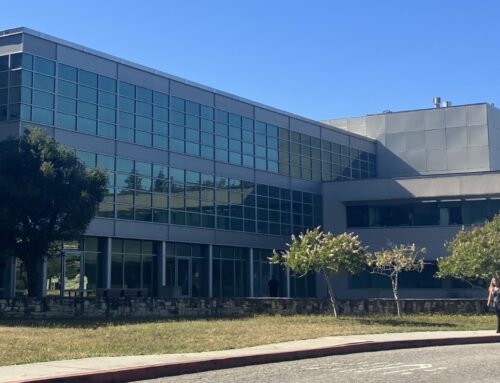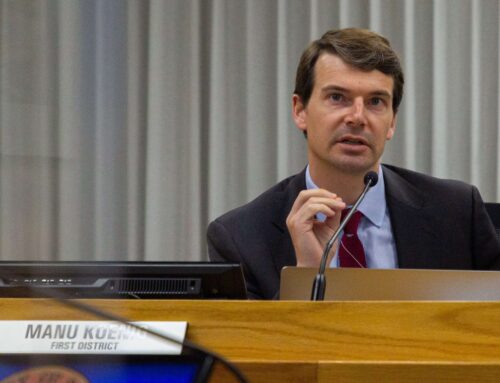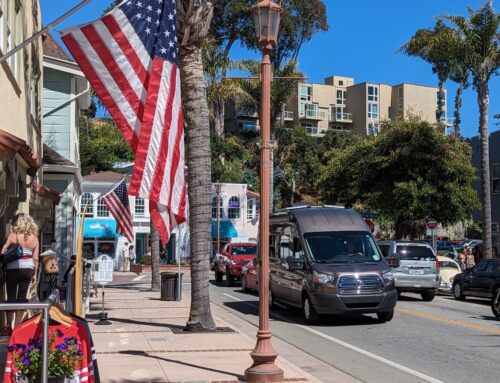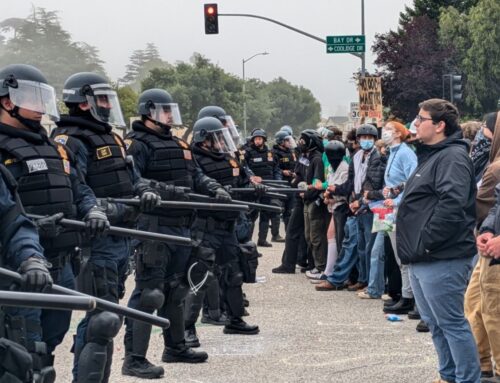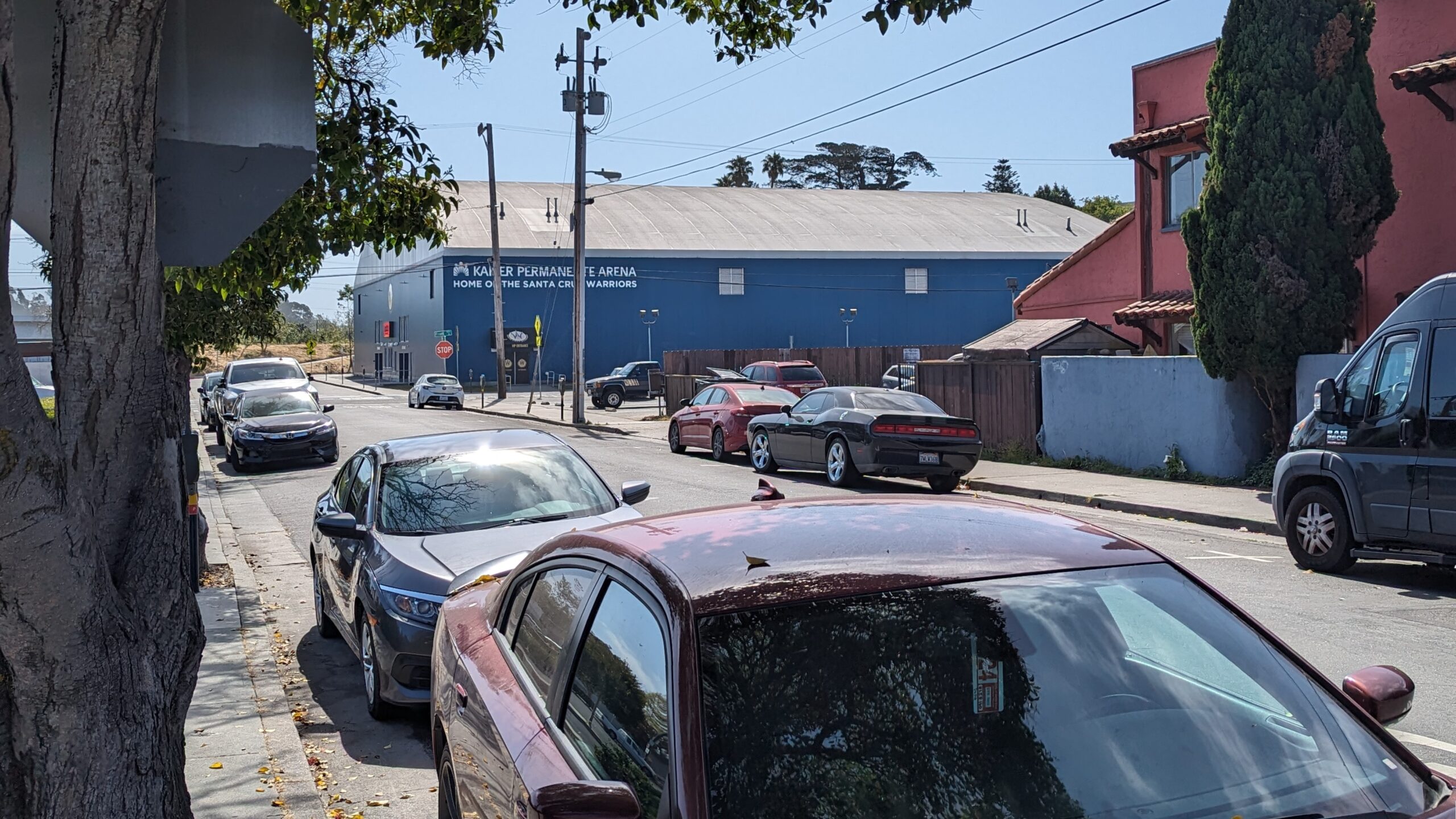
Spruce Street could close to vehicles from Pacific Avenue to the San Lorenzo River levee as part of a proposed Santa Cruz Downtown expansion plan. (Stephen Baxter — Santa Cruz Local)
Key takeaways
- Santa Cruz city staff released a draft plan to allow taller buildings south of Laurel Street, build a public plaza and clear the way for a larger arena for the Santa Cruz Warriors basketball team.
- The city hopes to incentivize developers to build more affordable housing.
- Public input will be gathered at a June 18 meeting.
SANTA CRUZ >> A new draft of Santa Cruz’s downtown expansion plan calls for buildings up to eight stories and wider sidewalks south of Laurel Street, as well as a permanent, larger Kaiser Permanente Arena for the Santa Cruz Warriors basketball team.
A public plaza at Front and Spruce streets is also in the plan, along with new bike lanes and parts of Spruce Street closed to vehicles. City staff want residents’ feedback through July 10 as part of a yearlong approval process.
The plan aims to create new housing and public spaces, spur economic growth and entice the Warriors to stay in Santa Cruz. The plan is a blueprint for future development, but it does not guarantee new buildings.
Santa Cruz Senior Planner Sarah Neuse said that closing Spruce Street to vehicles and creating a plaza would provide space for community events. “People want a gathering place,” Neuse said. “They want a heart of the city,”
- Buildings could be up to 85 feet in some areas, or roughly eight stories. However, state density bonus laws could allow buildings more than double that height if they provide enough affordable housing.
- Public feedback on the plan has been mixed, with some concerns about denser development and gentrification.
The plan could be approved by Spring 2025 but it could take decades to fully implement, city staff said.
The Santa Cruz City Council is set to discuss the draft plan at a study session 5:30 p.m. June 18 in the city council chambers at 809 Center St., Santa Cruz and on Zoom. City staff will accept comments on the draft Downtown expansion plan until July 10.
Jump to a section
- What is the downtown expansion?
- How did we get here?
- What would the downtown expansion look like?
- How tall would buildings be?
- What’s the process for approving the plan?
- How would the city pay for wider sidewalks and other parts of the plan?
- When would the plan be carried out?
- What do people think about the draft plan?
What is the downtown expansion?
The Santa Cruz City Council in 1991 approved a development plan for downtown to spur recovery from the 1989 Loma Prieta earthquake. Now, city leaders are hoping to expand the Downtown Plan south, from Laurel Street to Pacific Avenue and Center Street.
How did we get here?
City efforts to expand downtown started in earnest in 2021 as part of a plan to allow for more housing and accommodate a new arena for the Santa Cruz Warriors.
- A 2022 vision for the plan would have allowed five buildings 145 feet or higher, including one up to 225 feet tall. The Santa Cruz Planning Commission, and many residents, advocated for lower height limits.
- In 2023, Santa Cruz Mayor Fred Keeley led an effort to scale back the plan to a maximum of 12 stories.
The plan was part of the impetus for Measure M, which would have required a citywide vote to change height limits. About 60% of Santa Cruz voters rejected the measure in the March 5, 2024 election.
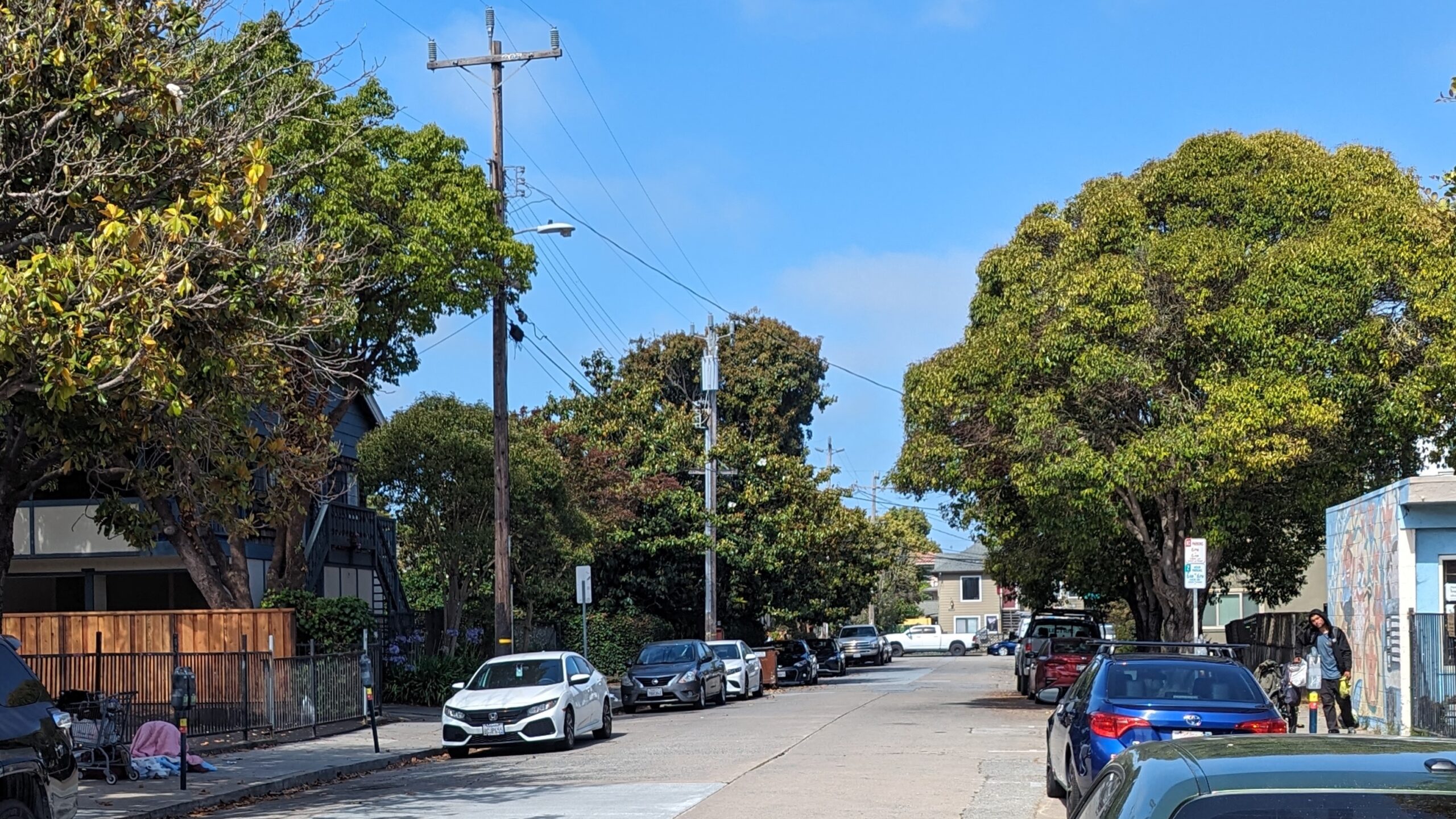
Two-story apartment buildings and single-story shops and homes now line Spruce Street from Pacific Avenue to Cedar Street in Santa Cruz. A draft of Santa Cruz’s downtown expansion plan would allow buildings up to 85 feet or roughly seven stories. (Stephen Baxter — Santa Cruz Local)
What would the downtown expansion look like?
As described in the newest draft plan, the expansion would include:
- Taller buildings. Height limits vary by block (see map) and range from 50 to 85 feet. State density bonus law could allow taller buildings.
- More homes. City staff project that the plan would add about 1,600 apartments. They aim for 20% of those units to be income-restricted affordable. City staff are also working on a plan to ease the impact of gentrification on current residents. State law requires developers to offer residents displaced by new development Because the area is close to the Santa Cruz Metro bus depot, state law means the city cannot require parking spaces in new developments.
- A new arena. A 3,200-seat Santa Cruz Warriors arena could be built on Spruce Street on either side of Front Street. The stadium would be available for concerts, conferences and other events. The current arena has 2,505 seats.
- A public plaza at the intersection of Spruce and Front Streets.
- A car-free Spruce Street from the San Lorenzo River levee to Front Street, and possibly later to Pacific Avenue. A parking lot north of Spruce Street would be open for development.
- A new street. Laurel Street Extension would be rerouted south of the existing Warriors arena to connect Pacific Avenue and Beach Hill. An existing portion of the road adjacent to the river levee would be closed and available for development.
- Expanded bike lanes and sidewalks, including a protected bike lane on Laurel Street and widened sidewalks on Pacific Avenue and Front and Center streets.
- A revamped Riverwalk along the San Lorenzo River levee, with more access from downtown, more public seating and new landscaping.
Any of these details could be changed based on public and city council feedback, said Santa Cruz Senior Planner Sarah Neuse. “Nothing is ever in stone,” she said. “It’s not a material we work with.”
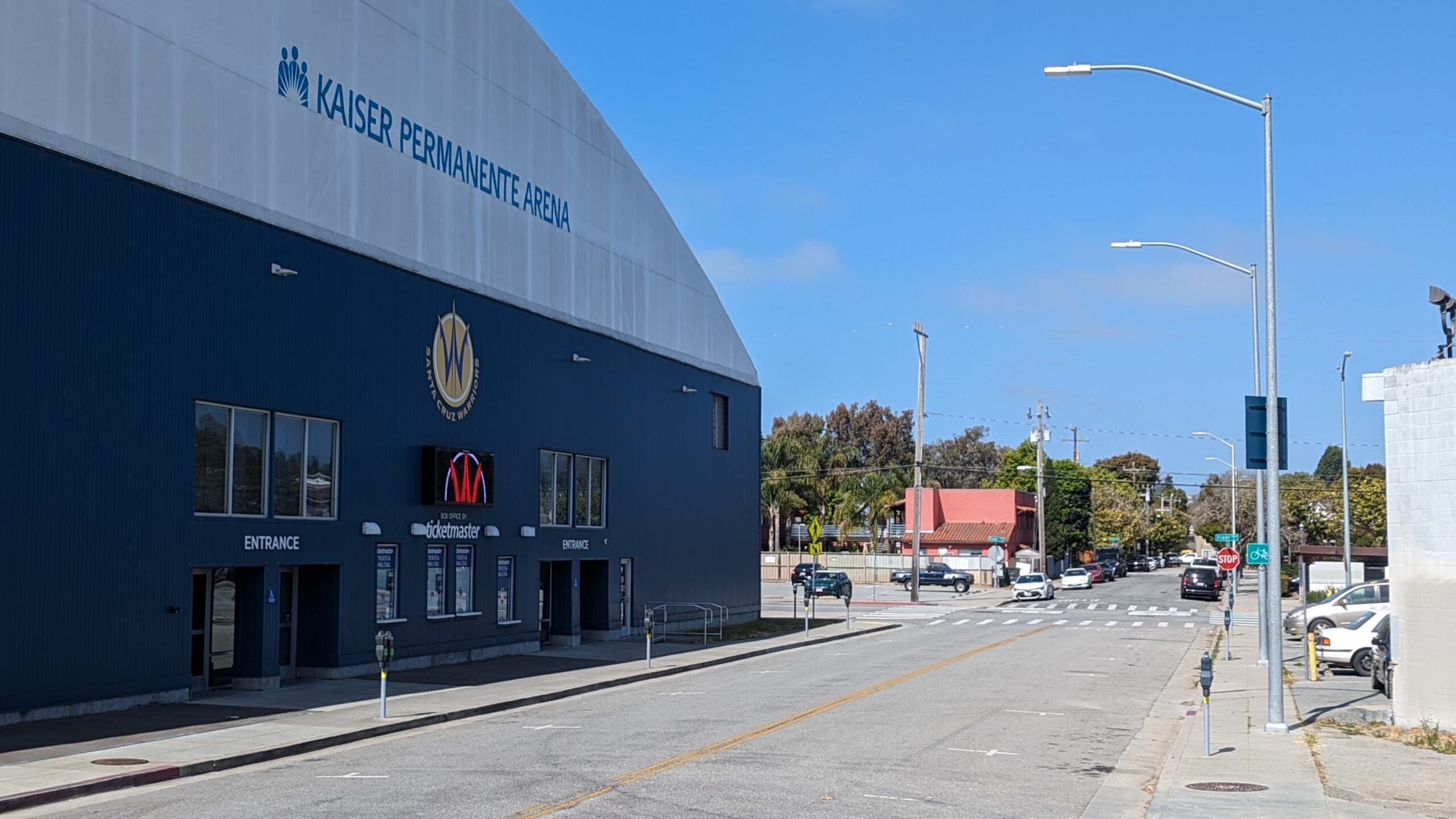
Spruce Street from the San Lorenzo River levee to Front Street could be closed to vehicles as part of a proposed Santa Cruz Downtown expansion plan. A permanent arena could be built and expanded at the same location or across Front Street. (Stephen Baxter — Santa Cruz Local)
How tall would buildings be?
The draft plan includes blocks with height limits of 50, 75 and 85 feet, plus 15 feet for rooftop features like bars. It also increases the allowable total floor area of a building, essentially allowing developers to build on a larger portion of their land.
Persuading developers to accept those limits will take some negotiating.
That’s because state density bonus laws enacted this year allow some developers to double the number of homes in a new building — with no height limit at all. Santa Cruz got its first taste of the new law with the Clocktower Center, a proposed 16-story building on North Pacific Avenue. For scale, the Palomar building on Pacific Avenue is 90 feet and seven stories.
City staff plan to offer incentives for developers to stay within 12 stories and allocate more affordable apartments than the city-mandated 20%. The draft plan doesn’t include specific incentives. Neuse said city staff are still looking into their options, and welcome more ideas.
- One possibility could allow developers to increase the total floor area of the building. That could mean decreasing the distance the building is set back from the street, shrinking or omitting required open space, or nixing requirements for upper floors to be smaller than the base.
- Another possible incentive for developers to limit height and contribute more affordable housing could be to let developers fund construction of income-limited apartments at nearby nonprofit-helmed projects rather than their own buildings.
The city’s zoning code now limits building heights in part of the expansion area to 35 feet, but the city’s General Plan doesn’t have a height limit for much of the area. State law states that the less permissive rule reigns, so most of the expansion area legally does not have an existing height limit, said Santa Cruz Principal Planner Matt VanHua. The expansion zone does have a floor-area ratio limit, which essentially limits developers to a short building that uses more of their land, or a taller, skinnier building. The expansion plan would increase the allowable floor-area ratio in that zone.
What’s the process for approving the plan?
The approval process for the plan is expected to include:
- A public review of the released draft until July 10.
- An environmental report, which will have its own public review. The environmental report may be released in September, Neuse said.
- Public hearings for the final draft of the plan at the Santa Cruz Planning Commission, Santa Cruz City Council and California Coastal Commission. “If everything goes very smoothly, to plan,” the Coastal Commission could approve the plan by mid-2025, Neuse said.
How would the city pay for wider sidewalks and other parts of the plan?
The city could create a new tax district in the expansion zone to pay for public aspects of the plan, like widened sidewalks. The area, known as an enhanced infrastructure financing district, wouldn’t raise taxes or add new ones. Rather, as property values in the area increase, a portion of the increased property tax could be dedicated to city projects in the district. The district would require its own approval process separate from the expansion plan.
The city budget and state or federal grants could also fund some improvements.
When would the plan be carried out?
The plan could take decades to fully come to fruition. “The initial Downtown Plan was written in ‘91, so that’s more than 30 years ago, and it’s not fully built out,” Neuse said.
Many of the elements depend on the pace of private development, she said. Some public features, like sidewalk expansion, would require private properties to redevelop and dedicate some land to the city.
The relocated Laurel Street Extension would run through land now occupied by Front St. Residential Care, which houses seniors and provides mental health support. The County of Santa Cruz owns the land and would be responsible for relocating residents before the city can construct the road, Neuse said.
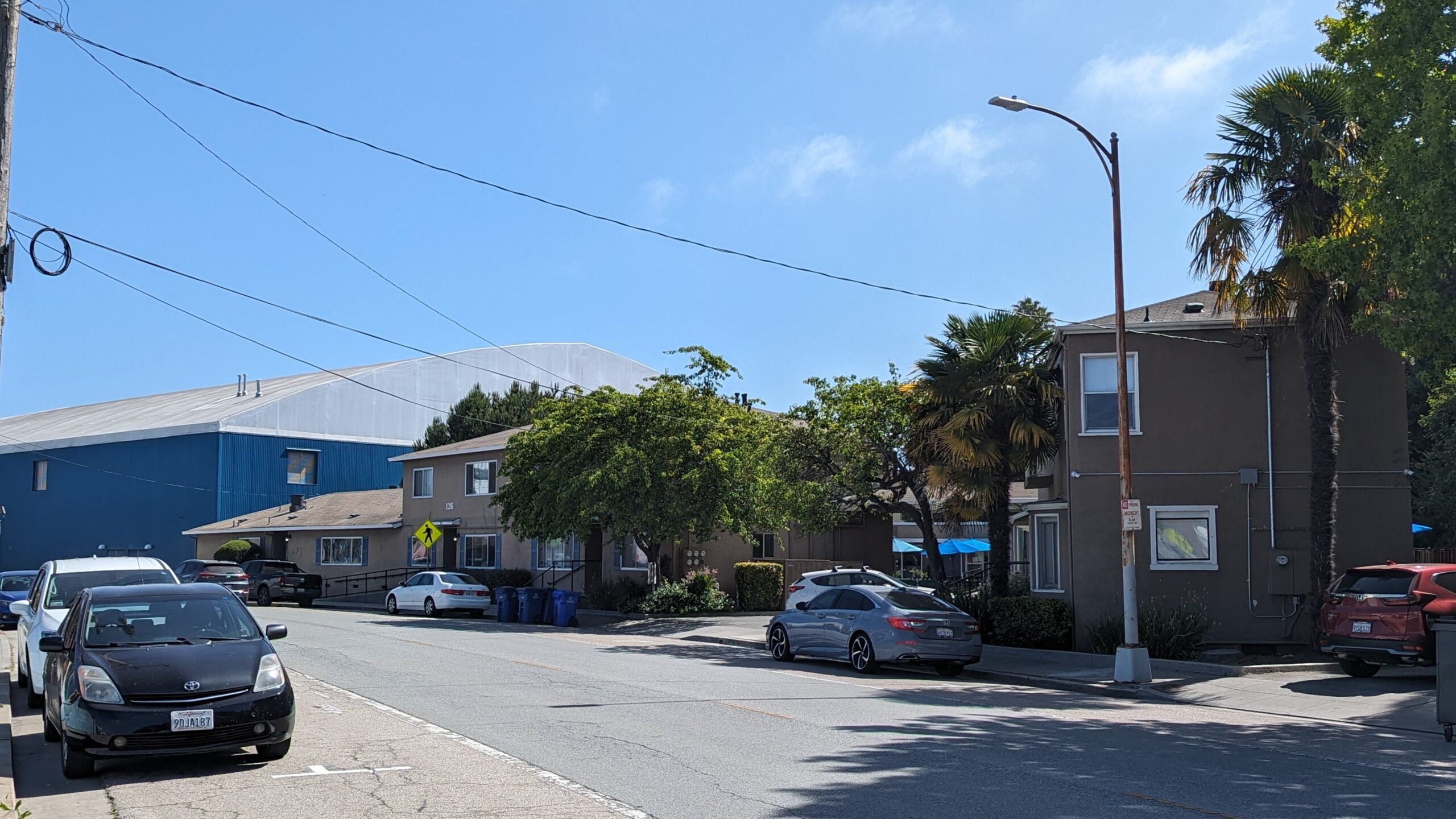
Front St. Residential Care, right, houses seniors and provides mental health support on county owned land next to Kaiser Permanente Arena in Santa Cruz. (Stephen Baxter — Santa Cruz Local)
No immediate plans exist to relocate the facility or its residents, said county spokesperson Jason Hoppin. “We will continue to engage and work with the city about the future of this property as it relates to the Downtown Plan, but are committed to preserving this important community resource either in its existing location or at a new site,” he said.
What do people think about the draft plan?
Frank Barron, a former Santa Cruz County planner and architect of the defeated Measure M, opposes rezoning the area to allow taller buildings. “There’s going to be plenty of tall buildings” under existing city rules because of state density bonus laws, he said.
VanHua, the city planner, said that as the city plans to allow for more housing, staff can’t assume that developers will use density bonuses. For example, the city can’t include anticipated density bonus units in its Housing Element, a plan to meet state housing goals.
But the proposed incentives for developers to limit height could be helpful, Barron added. “I think they should have those anyway,” he said.
Barron added that he was concerned housing or other buildings next to the river would be vulnerable to potential flood damage.
Because the city can’t mandate new parking as part of new development, and doesn’t have to consider traffic impacts in its environmental report, implementation of the plan could create “massive gridlock,” Barron said.
Although he’s in favor of public transportation and biking, “the reality is, a lot of people, most people are going to be using cars,” he said.
Rafa Sonnenfeld, policy director for the pro-housing group YIMBY Action, said the city should have considered even taller height limits. The plan would likely add about 1,100 apartments before density bonus units, about 200 more than would be expected under existing rules, according to VanHua. Sonnenfeld would like to see a larger increase.
“This is a very modest increase to what is already legally allowed,” Sonnenfeld said.
He said he’s in favor of widened sidewalks, but opposes the requirement for developers to give up part of their land to accommodate them. And he said he’s disappointed that a portion of Pacific Avenue requires cyclists to share a street lane with cars.
Read more
- City of Santa Cruz page for the Downtown Plan expansion
- Santa Cruz City Council advances plan to reshape downtown — Jun. 15, 2022
- Santa Cruz Warriors explore new arena project with housing — Feb. 1, 2022
- Santa Cruz Downtown Plan could expand to build more housing — March 23, 2021
- Santa Cruz Downtown expansion plan scaled back — January 10, 2023
Questions or comments? Email [email protected]. Santa Cruz Local is supported by members, major donors, sponsors and grants for the general support of our newsroom. Our news judgments are made independently and not on the basis of donor support. Learn more about Santa Cruz Local and how we are funded.
Jesse Kathan is a staff reporter for Santa Cruz Local through the California Local News Fellowship. They hold a master's degree in science communications from UC Santa Cruz.


